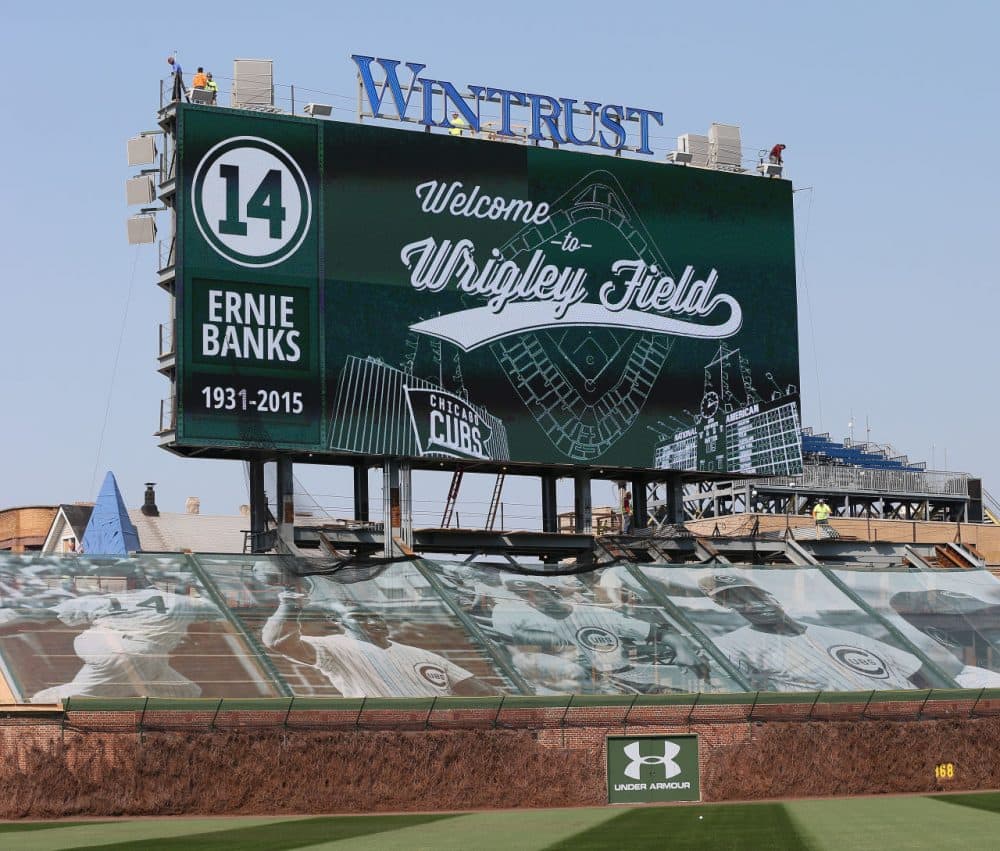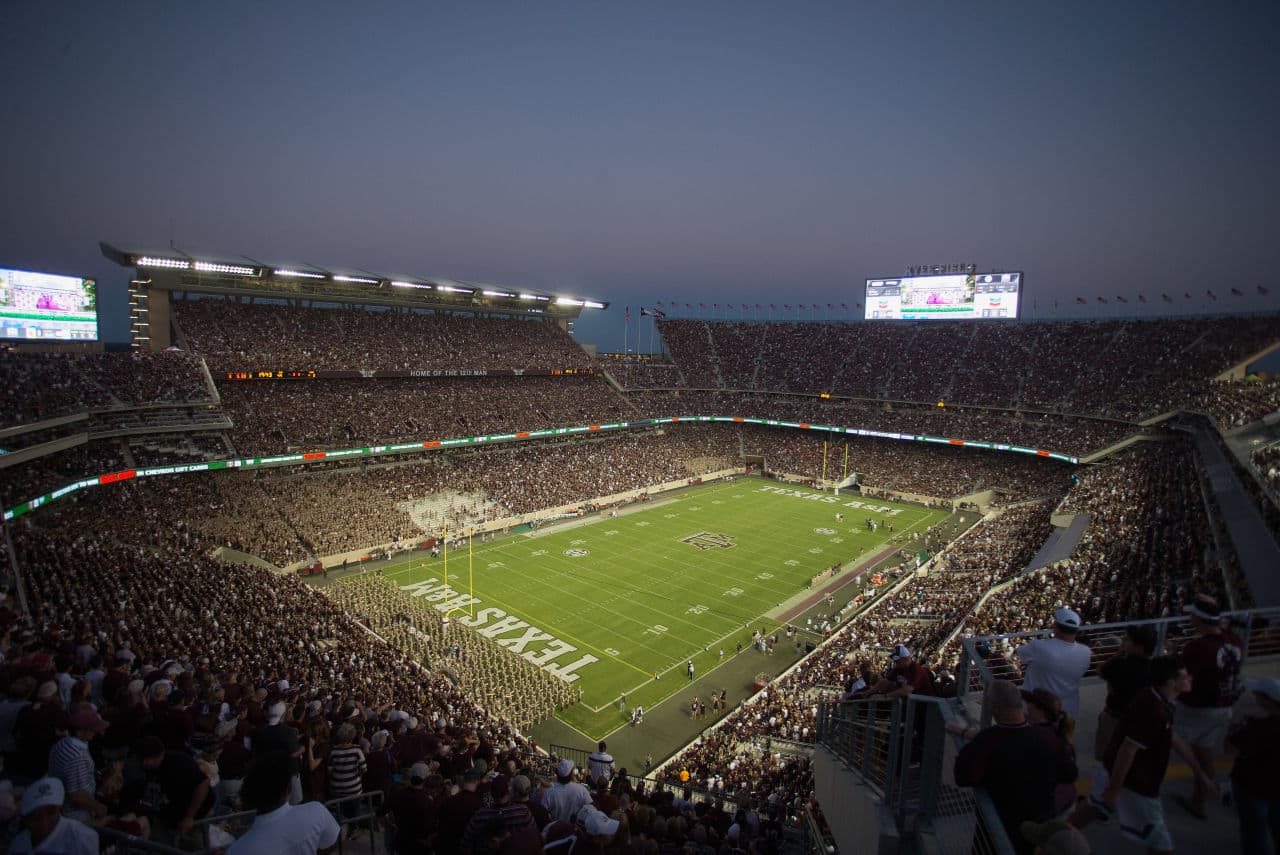Advertisement
The History — And Uncertain Future — Of The Jumbotron
Resume
How do fans stay entertained during breaks in the action? The jumbotron has become a fixture at sports stadiums, ever since a large video screen first appeared at the 1980 MLB All-Star game in Los Angeles.
Mary Pilon has written about the history — and uncertain future — of the jumbotron for SB Nation, and she joined Bill Littlefield.
BL: The 1985 World Expo in Japan seems to have been a turning point in so-called "Jumbotron history." Please explain.
MP: I started at the beginning — or tried to — in terms of understanding, "Where did this come from?" "Who coined the term?" "Who created it?" Sony launches this, and it's rolled out at the expo, but then also is actually purchased, and people actually start using them.
And there's kind of two audiences that really gravitate towards the idea of having this large screen, and that's sports arenas and megachurches. It was not too surprising that those were the two groups that really early on benefited from the Jumbotron and really embraced it.
BL: Has the purpose of the Jumbotron evolved?
MP: It used to be you just had scores, you just had numbers up there. And then you had instant replay. And now you're seeing things in arenas where people are trying to incorporate social media into it. So, "Tweet something, and we'll put your image or an Instragram that you post up here." And they're trying to bring peoples' screens that are in their hands now onto the larger one.
Texas A&M, where I spent some time reporting for this story, they were really careful about what they were going to show on the Jumbotron — so how many ads. They don't want it to be a giant thing for commercials, so there are some lines being drawn, for sure.

BL: One of the lines that hasn't been drawn involves the "Kiss Cam." I don't know how to speak about this in any way that's appropriate for a mixed audience. But, anyway, tell us about how the kiss cam evolved.
MP: So it started, we think, in the '80s or '90s, around the time that Jumbotrons did. The kiss cam comes and it is unpredictable. And one of the things I love about it is that it is one of the few areas in media today where you really do see real people. They don't have stylists. There's no makeup.
But that said, it's really strange. Like it's really weird, and there are all sorts of really funny stories and YouTube reels of, "Are they siblings?" "Are they exes?" "Are they having an affair?" I mean, this has blown up in so many ways. So it has been this kind of fascinating catalyst and kind of this side show.
BL: You speak about the people who appear on the Kiss Cam as real people. But they're real people who are changed by the fact that they're suddenly on that Jumbotron, aren't they? They become something other than themselves at that point. They become part of the show.
MP: Absolutely, absolutely. And I think that that's part of the appeal of it. I think in an era of social media where people can replicate that more on their own, the awe of the Jumbotron is kind of muted, right? Because it used to be that was the only way to put yourself out there, and now, I mean, think about video, think about Facebook, think about Twitter. You know, I'm very curious in the next five or 10 years to see if the Kiss Cam kind of fades away or if people kind of get into it as a nostalgia thing. I'm not sure.
BL: It's interesting to me that given all of these wonderful things that the Jumbotron can do, you're somewhat concerned about its future. The future seems to you uncertain?
MP: Absolutely. I mean, I think that's true for broadcast in general. And sports is interesting because it's one of the few areas in television that has held up in terms of ad dollars. And you're seeing these huge contracts for the rights to the NBA, the Olympics and all these other things because live still matters in an era of DVR and people cutting their cords.
The other thing — and I think this is a problem with football in particular — is that the at-home experience has gotten so good. You think about the angles and the this and the that. Even getting people into these stadiums now, it's still kind of an issue depending on what sport you're talking about. And the Jumbotron is the least of that. I think there are some bigger, broader trends that are impacting how we watch teams and how we follow them.
BL: Finally, since the theme of this week's show is "home," I've got to ask you if the homes of the various teams, in your judgement, have been rendered less "homey" by the Jumbotron experience?
MP: I don't know. It's funny because so much of sports, especially if you think about home and your home team and your identity, is it's about that. I think there's always going to be a core of sports fans, whether the team wins or loses, who is going to have almost a spiritual connection to a stadium, an arena, a ballpark. So I think it has changed it. But I think the core of it, the guts of it, that's probably going to stay with us for a long time.
This story was produced as part of Only A Game’s “Celebration of Home.”
This segment aired on November 28, 2015.